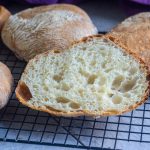Homemade Ciabatta Bread
This Italian bread is known for its air holes, or "alveoli." The loaf is perfect for sandwiches, panini, and for soaking up olive oil, soup broth, and more.
Servings: 2 large or 4 "sandwich" size loaves
Ingredients
For the Biga:
- 250 grams bread flour (12.7% protein)
- 250 grams (1 cup) room-temperature water
- 2 grams (or a rounded 1/4 teaspoon) instant yeast
For the final dough:
- 250 grams bread flour
- 4 grams (or 1 teaspoon) instant yeast
- 8 grams (or 1 1/2 teaspoons) salt
- 125 grams (1/2 cup) room-temperature water
For greasing:
- 2-3 teaspoons olive oil
Instructions
Making the Biga (do this 6-24 hours ahead of time):
- In a large mixing bowl, stir together the Biga ingredients until smooth. Cover the bowl with cling film, and let rest at room temperature for 6-24 hours. After this time, the Biga should be puffy and bubbly. You will know it's alive!
Making the final dough:
- Pour the ingredients for the final dough on top of the Biga. Stir brusquely with a stout wooden spatula until combined.
Kneading the dough:
- Knead the wet, sticky dough for 8 minutes. To do this, use the spatula to roughly manipulate the dough, lifting it up and letting it fall back into the bowl, and/or by stirring, Feel free to take 30 second rests whenever your arm gets tired from manipulating the dough!
Resting the kneaded dough:
- Grease a large, clean mixing bowl with some of the olive oil. Transfer the kneaded dough to the oiled bowl. Cover with cling film and let rest for 30-45 minutes at room temperature. (Use the greater time if your kitchen is below 70°F.)
The first fold:
- Grease your hands with olive oil. Then slide your hands under one end of the dough. Stretch that end upwards, and then fold it over the top. Repeat this same procedure for other end of the dough, as well as the sides. You will have 4 folds in total. Cover the bowl and let rest for 30-45 minutes.
The second fold:
- Repeat as for the first fold. At this point, you will notice the dough has developed just a hint of structure. Cover and rest the dough for 30-45 minutes.
The third and final fold:
- Repeat as before. By now you will feel a definite change in the dough -- it will be less sticky, and more elastic.
Forming the loaves
- Generously flour your work surface. Also, line a baking sheet with parchment. Without deflating the dough, turn the bowl upside down on the floured surface, and let the dough naturally (and slowly) drop onto the flour. Generously flour the top of the dough. Use a floured bench scraper to gently form the dough into a square. Then use the scraper to cut the dough in half for 2 loaves. If desired, cut each half in half to create 4 loaves.
- Taking care not to deflate the dough, lift each loaf and place them, upside down, on the parchment-lined baking sheet. Cover with a tea towel and let rest until nearly doubled in volume -- 45-60 minutes.
- Meanwhile, adjust the oven rack to the upper third level. Preheat the oven to 450°F.
Baking the Ciabatta -- 30 minutes at 450°F
- Put the baking sheet in the preheated oven. Then quickly mist the loaves with water, and close the oven door. Mist the loaves 3 times during the first 5 minutes of baking, always quickly opening and closing the oven door. Bake until the bread is richly browned -- about 30 minutes. Cool completely on a wire rack.
